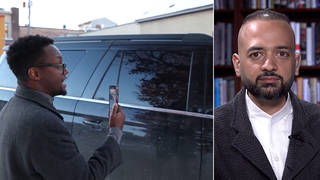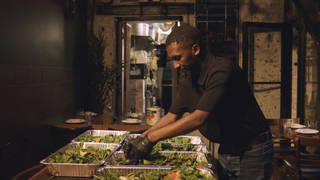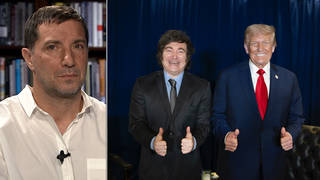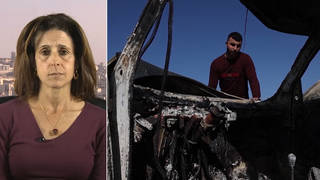
Topics
Guests
- Patricia Isasasurvivor of torture under the Argentine dictatorship of 1976-1983. She is currently a member of the Argentine Truth Commission.
We speak with Patricia Isasa, a torture survivor from Argentina’s military dictatorship. She was a 16-year-old student union organizer in 1976, when she was kidnapped by police and soldiers and tortured and held prisoner without trial for two-and-a-half years at one of the 585 clandestine detention and torture centers set up during the dictatorship. After a long legal battle to bring her torturers to justice, six of her nine torturers were recently sentenced to prison. [includes rush transcript]
Transcript
AMY GOODMAN: We’re broadcasting from Buenos Aires, Argentina, not far from the secret prison that during the period of the military dictatorship functioned as the nerve center of its regime of torture, the Naval Mechanics School known as ESMA.
Well, now I’m joined by a torture survivor from the dictatorship, Patricia Isasa. She was a 16-year-old student union organizer in 1976 when she was kidnapped by police and soldiers, tortured and held prisoner without trial for two-and-a-half years at one of the 585 clandestine detention and torture centers set up during the dictatorship.
After a long legal battle to bring her torturers to justice, six of her nine torturers were recently sentenced to prison. The other three had died. In 2006, former president Néstor Kirchner ordered her into a witness protection program after the sudden disappearance of Jorge Julio López, another torture survivor who had recently testified against his abusers.
A 2005 documentary about Patricia Isasa’s ordeal called El Cerco features interviews with some of her torturers, who were awaiting trial at the time. In the film, Patricia revisits the sites where she had been held. She describes her torture.
PATRICIA ISASA: [translated] I arrived here for the first time when I was 16 years old, July 30th at noon. They forced me through this hallway. This place was empty. First, they slammed me against the wall. They dragged me across the floor. They beat me. Then they tied my feet to my hands, which were already handcuffed. I was kept like this for one week. Two men appeared, and one of them told me I had to talk. He said that the other guy was crazy and I should talk for my own good. This crazy guy was Eduardo Ramos.
EDUARDO RAMOS: [translated] I entered the police force in 1973. While I was working for the police as an analyst, the government was overthrown. My job was to monitor terrorist groups in universities. Some people call it “going undercover.”
PATRICIA ISASA: [translated] After two days, they took the hood off me. They gave me water, a lemon, and they took me to the bathroom. Then Ramos and the other guy came back playing good cop and bad cop. I was told that Ramos was going to kill me and I’d better talk.
EDUARDO RAMOS: [translated] I was not a typical policeman. I was more of a secret agent than a regular cop.
PATRICIA ISASA: [translated] I was thrown here. Ramos gave me a warning. He was insinuating that I would be raped. He said, “Tell me if anyone touches you, because we are the only ones that can touch you.” I was 16 years old. I couldn’t believe it. Ramos was telling me, “You are my property. If I want, I can rape you.”
Ramos was a spy at this law school. He turned in a lot of students here while pretending he was a law student.
My next step was to reconstruct my captivity at Police Station 4, where I learned what it was like to be tortured. This was a camp for torture and extermination run by Mario José Facino in 1976. Over here. This is it. It’s this place and this here. It’s both of these. These are the places where they tortured us. We’re looking at them from the outside, but I’m convinced, I’m telling you.
No, I can’t talk. Look, this is it. This is the place. They were over here. On this floor and at this window. This is where I spent the worst days of my life, simple as that. This was stuck, but I managed to open it. And through here, you could see, as you can now, the school. You can manage to see the school. These cracks — if you excuse me — this was stuck. You couldn’t open it. But to be able to see the school, I could suspect what street I was on and where I was being held. After talking with other detainees, we figured out that we were being held at the Police Station 4.
I never thought that I would be standing in front of the bench that I was locked to. It’s incredible. Twenty, 25 years have passed. The bench that I was locked to when I was 16 is still here, same as ever. No one came to look at this place.
AMY GOODMAN: That was an excerpt of the 2005 television documentary El Cerco, made by Telefe, an Argentine television network.
Well, Patricia Isasa is joining me here in Buenos Aires. She’s currently a member of an Argentine truth commision and continues to fight for justice for all Argentines.
Last Christmas, Christmas of December 2009, was a very big moment for you. Patricia, we leave the documentary where you’re standing in front of the bench you were tortured. You were 16 years old.
PATRICIA ISASA: Yeah. Well, and finally I found justice. Finally, I could put on trial the person, Brusa, who was my interrogator. But the society could put on trial the federal judge. I could put on trial the person who was the chief or the boss over the concentration camp, but the society could put on trial the mayor.
AMY GOODMAN: So, you’re putting on trial the civilians, not the generals.
PATRICIA ISASA: The generals and — both of them.
AMY GOODMAN: This was unprecedented.
PATRICIA ISASA: Both of them. The generals, the policemen and the civilians. And that is very, very important.
AMY GOODMAN: What did the judge do?
PATRICIA ISASA: Well, the judge, he received a sentence. The judge was an interrogator. During this — during my time when I’d been in the concentration camp, he was my interrogator. And he’d been in the torture place. He was the main guy in the torture place. You know, the interrogator is the person who command, more or less a dictator for the torture. They say “stop” or “continue” or “kill.” This guy, because we have so many times impunity to law, he be in a — further a judge. But finally, we could put on trial, and now he’s behind bars, and he received a sentence last December for 23 years in jail. In a maximum-security jail, he’s today.
AMY GOODMAN: You had six people —
PATRICIA ISASA: Yes.
AMY GOODMAN: — ultimately.
PATRICIA ISASA: Yes.
AMY GOODMAN: You pursued them —
PATRICIA ISASA: Yes.
AMY GOODMAN: — until they were tried and put in jail.
PATRICIA ISASA: Yes, yes. Exactly, yes.
AMY GOODMAN: Today you are a member of a particular truth commission in Argentina.
PATRICIA ISASA: Yes.
AMY GOODMAN: In these last few minutes, if you can tell us about it.
PATRICIA ISASA: Well, it’s a truth commission, Papel Prensa. Papel Prensa, to be quick, is a big company. The owners was a Jewish family. And during —- the dictators, you know, they were close to the Nazis’ ideas. And they decided to take off the company, and they made a deal between the newspapers and the dictatorships. And -—
AMY GOODMAN: This was the Clarín newspaper?
PATRICIA ISASA: Yes, Clarín and La Nación, and another newspaper, but they broke. But Clarín and La Nación. And during this time, the owner for Clarín and the owners for La Nación, they — well, they met for the interrogators for these families. What happened was Papel Prensa, first they put pressure — the newspaper put pressure for the families to try to push to sell the company. With the widow, they tried to push, pressure, to sell the company. Then, finally, during November, he sold the company. The company — the value for the company was $45 million, but she received $7,000.
AMY GOODMAN: When was this? What year?
PATRICIA ISASA: During November 1976.
AMY GOODMAN: So these newspapers forced this family —
PATRICIA ISASA: Forced this family to —
AMY GOODMAN: — to give up their paper?
PATRICIA ISASA: — to give up the — yes. Then, they made a contract to say, well, we are — they will be able, the newspapers, Clarín and La Nación, they will be able to pay $1 million. Remember, the value for the company was $45 million. But you know what happened two weeks before when they had to pay? The militaries kidnapped all the family.
AMY GOODMAN: Of the original owners of the newspaper.
PATRICIA ISASA: Of the original owners. They kidnapped all the family. And the newspaper said, “Oh, we don’t know what happened with the family.”
AMY GOODMAN: And the picture that you brought with you is a picture of?
PATRICIA ISASA: This picture is a picture —- is one of the proofs -—
AMY GOODMAN: Of General Videla, the coup leader.
PATRICIA ISASA: With General Videla, exactly.
AMY GOODMAN: The military junta leader.
PATRICIA ISASA: Exactly. With Ernestina Herrera de Noble, with the owners. She’s the owner of Clarín. And she — in addition, she have a trial.
AMY GOODMAN: Toasting the new owners.
PATRICIA ISASA: Exactly. She have a trial, because she have two — she adopted two kids. But we have a pretty —- a big suspect, because she has -—
AMY GOODMAN: A big suspicion.
PATRICIA ISASA: Exactly. She have two kids for the families of the disappeared.
AMY GOODMAN: You feel. You suspect.
PATRICIA ISASA: Exactly. She’s on trial. We suspect. She’s on trial. And she refused — she refused for nine years. She refused to —- well, to participate in justice. Not, of course, [inaudible] -—
AMY GOODMAN: To do DNA testing of the children.
PATRICIA ISASA: Exactly, exactly. If —- no, if these kids, their -—
AMY GOODMAN: We have five seconds.
PATRICIA ISASA: Exactly.
AMY GOODMAN: Well, Patricia Isasa, I want to thank you for being with us, as I sit here in front of the California legislature certificate they gave you — Patricia Isasa, human rights activist and member of the truth commission Papel Prensa — that you were awarded in Los Angeles.












Media Options